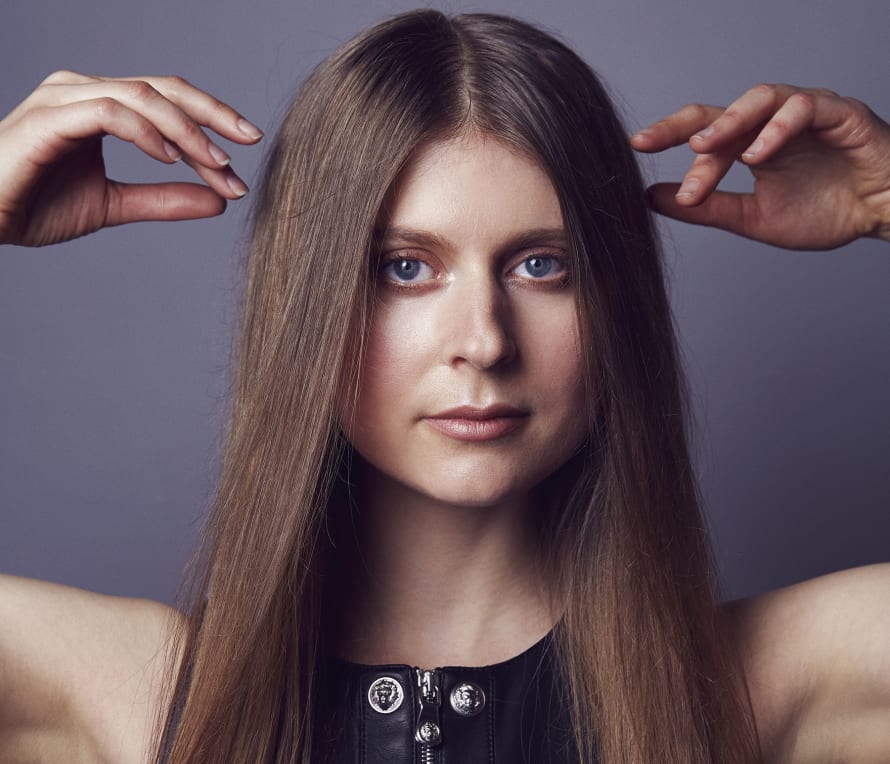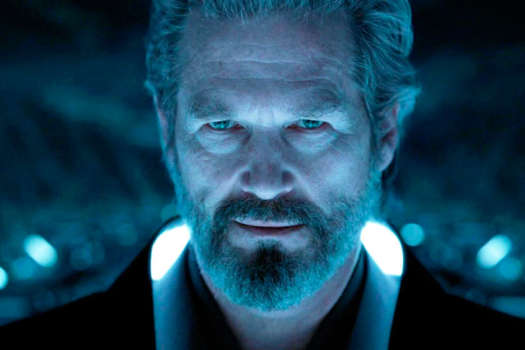Casual fans might note a more pop-oriented sound to Lydia Ainsworth's second album, Darling of the Afterglow, compared to her debut, but take a closer listen and it's apparent: Ainsworth's been writing pop songs from the start.
"I think it's more the fact that I wanted to take things to the next level with production and songwriting," Ainsworth tells Exclaim!, over tea in Toronto's Danforth neighbourhood.
On top of the fact that she studied music at NYU, Right From Real's classical signifiers — the carefully arranged strings, the choral vocals — made it easy to label Ainsworth as an "experimental" artist, but it was her captivating melodies that first ensnared listeners' ears, and it's melody doing it again on Darling, out March 31 courtesy of Arbutus/Bella Union. As Ainsworth explains, it's mostly the result of increased production value.
"I was conscious of 'Is this a good hook?,' conscious of song form, even though I stray from traditional pop song structure on this album. But yeah," she reiterates, "those are all considerations I had on Right From Real, as well."
As with any student of music, Ainsworth's definition of a "pop song" is perhaps broader and more inclusive than most, a product of prolonged exposure to sounds as varied and disparate as atonal music and Top 40.
"I've always loved pop music. I went to school studying academic classical composition, and really never connected with avant-garde style composition, so I was attracted to film scores and composers like Philip Glass — which is the minimalist vibe I was writing in with [early EP] Island to Island. So for me, that's sort of considered pop music. But as a kid, I loved anything pop-related. I was obsessed with [Canadian "youth television" channel] YTV's The Hit List and MuchMusic, but also listening to any album I got my hands on as a kid.
"My dad read MOJO magazine, so I'd get all the albums that would come with that: 'Roots of Hip-Hop,' 'Roots of Techno,' all those kinds of things. I was obsessed with songs and song form. I feel like it's just the most natural form of expression for me now."
But it was touring, primarily, that Ainsworth cites as the biggest factor in Darling of the Afterglow's sound — namely, an increased focus on vocals.
"I had never toured before releasing the album, so that was a huge change in my life. Having to perform and really rely on my voice every single night, I think, gave me a new kind of confidence for this album. I feel like my last album, I layered my voice a lot more, or maybe it was a little more in the texture of things, but now it's more up front. I think that came from touring and playing live."
That confidence is apparent throughout the new album. On "Ricochet," Ainsworth bends her powerful alto tightly around a serpentine synth line, while album opener "Afterglow" finds her testing the lower and upper boundaries of her vocal range in its call-and-response verses. "Into the Blue," meanwhile, features an emphatic, borderline-operatic performance.
These songs, Ainsworth says, are "about capturing a feeling and expressing that in the most honest way I personally can." She cites Darling of the Afterglow's last song as a particular example of this.
"In the case of 'WLCM,' 'What Love Can Mean,' that was the fastest I've ever written a song in my life. I was just at my keyboard, playing the exact same synth part that you hear on the track, and I literally sang the melody and some of the words that became part of the song. The second take was actually the demo vocal that made it on the album. I had a very distinct image in my mind, as I do for all my songs."
"WLCM" was one of the two last songs Ainsworth wrote for Darling. That and album opener "Afterglow" came to Ainsworth on a trip to Los Angeles.
"I wrote my final two songs in L.A. I thought I'd finished the album at that point, and then I went out there and was actually trying to write for other artists, in hopes of collaborating with other songwriters. I was just going out there to try my luck."
Ever ambitious, Ainsworth was indulging a dream that, given her songwriting and arranging abilities, isn't altogether unrealistic.
"My ultimate dream would be writing with Sia. You've got to start somewhere! I just read an interview with Max Martin, and the way he describes working and his whole setup is just… that would be a dream for me. I would love to do that kind of stuff."
For now, though, Darling of the Afterglow finds Ainsworth successfully applying her formal musical education to a mode of musical expression driven as much by the heart as the brain.
"School was great for teaching me tools that I can either use or not, but it was also a great time to explore, spending time in the library looking at scores. I would just take out a Brahms symphony and look at the score, see how he would orchestrate. That definitely affects how I will arrange strings, or any kind of arrangement. Or even just finding out about Bulgarian singing, or field recordings.
"I wouldn't say I'm trying to throw it away," she says now, "but there does come a time when you're like, 'Okay, I do have the tools, but I'm going to put them aside and let my emotions guide what I want to do right now.'"
"I think it's more the fact that I wanted to take things to the next level with production and songwriting," Ainsworth tells Exclaim!, over tea in Toronto's Danforth neighbourhood.
On top of the fact that she studied music at NYU, Right From Real's classical signifiers — the carefully arranged strings, the choral vocals — made it easy to label Ainsworth as an "experimental" artist, but it was her captivating melodies that first ensnared listeners' ears, and it's melody doing it again on Darling, out March 31 courtesy of Arbutus/Bella Union. As Ainsworth explains, it's mostly the result of increased production value.
"I was conscious of 'Is this a good hook?,' conscious of song form, even though I stray from traditional pop song structure on this album. But yeah," she reiterates, "those are all considerations I had on Right From Real, as well."
As with any student of music, Ainsworth's definition of a "pop song" is perhaps broader and more inclusive than most, a product of prolonged exposure to sounds as varied and disparate as atonal music and Top 40.
"I've always loved pop music. I went to school studying academic classical composition, and really never connected with avant-garde style composition, so I was attracted to film scores and composers like Philip Glass — which is the minimalist vibe I was writing in with [early EP] Island to Island. So for me, that's sort of considered pop music. But as a kid, I loved anything pop-related. I was obsessed with [Canadian "youth television" channel] YTV's The Hit List and MuchMusic, but also listening to any album I got my hands on as a kid.
"My dad read MOJO magazine, so I'd get all the albums that would come with that: 'Roots of Hip-Hop,' 'Roots of Techno,' all those kinds of things. I was obsessed with songs and song form. I feel like it's just the most natural form of expression for me now."
But it was touring, primarily, that Ainsworth cites as the biggest factor in Darling of the Afterglow's sound — namely, an increased focus on vocals.
"I had never toured before releasing the album, so that was a huge change in my life. Having to perform and really rely on my voice every single night, I think, gave me a new kind of confidence for this album. I feel like my last album, I layered my voice a lot more, or maybe it was a little more in the texture of things, but now it's more up front. I think that came from touring and playing live."
That confidence is apparent throughout the new album. On "Ricochet," Ainsworth bends her powerful alto tightly around a serpentine synth line, while album opener "Afterglow" finds her testing the lower and upper boundaries of her vocal range in its call-and-response verses. "Into the Blue," meanwhile, features an emphatic, borderline-operatic performance.
These songs, Ainsworth says, are "about capturing a feeling and expressing that in the most honest way I personally can." She cites Darling of the Afterglow's last song as a particular example of this.
"In the case of 'WLCM,' 'What Love Can Mean,' that was the fastest I've ever written a song in my life. I was just at my keyboard, playing the exact same synth part that you hear on the track, and I literally sang the melody and some of the words that became part of the song. The second take was actually the demo vocal that made it on the album. I had a very distinct image in my mind, as I do for all my songs."
"WLCM" was one of the two last songs Ainsworth wrote for Darling. That and album opener "Afterglow" came to Ainsworth on a trip to Los Angeles.
"I wrote my final two songs in L.A. I thought I'd finished the album at that point, and then I went out there and was actually trying to write for other artists, in hopes of collaborating with other songwriters. I was just going out there to try my luck."
Ever ambitious, Ainsworth was indulging a dream that, given her songwriting and arranging abilities, isn't altogether unrealistic.
"My ultimate dream would be writing with Sia. You've got to start somewhere! I just read an interview with Max Martin, and the way he describes working and his whole setup is just… that would be a dream for me. I would love to do that kind of stuff."
For now, though, Darling of the Afterglow finds Ainsworth successfully applying her formal musical education to a mode of musical expression driven as much by the heart as the brain.
"School was great for teaching me tools that I can either use or not, but it was also a great time to explore, spending time in the library looking at scores. I would just take out a Brahms symphony and look at the score, see how he would orchestrate. That definitely affects how I will arrange strings, or any kind of arrangement. Or even just finding out about Bulgarian singing, or field recordings.
"I wouldn't say I'm trying to throw it away," she says now, "but there does come a time when you're like, 'Okay, I do have the tools, but I'm going to put them aside and let my emotions guide what I want to do right now.'"




